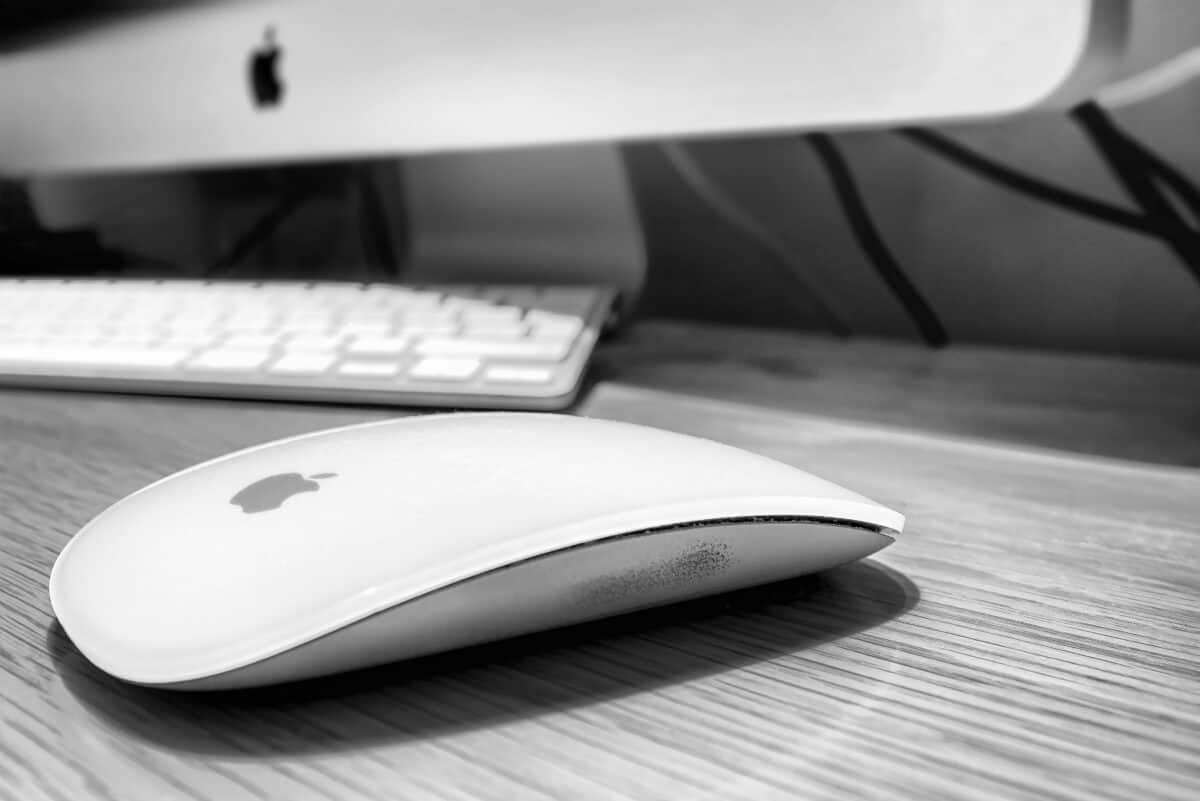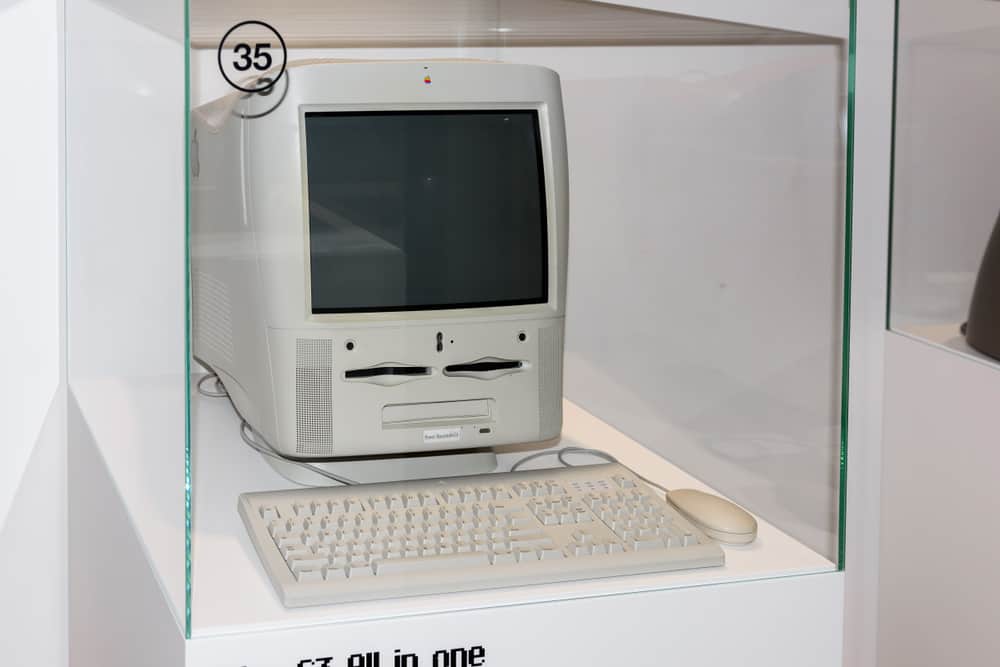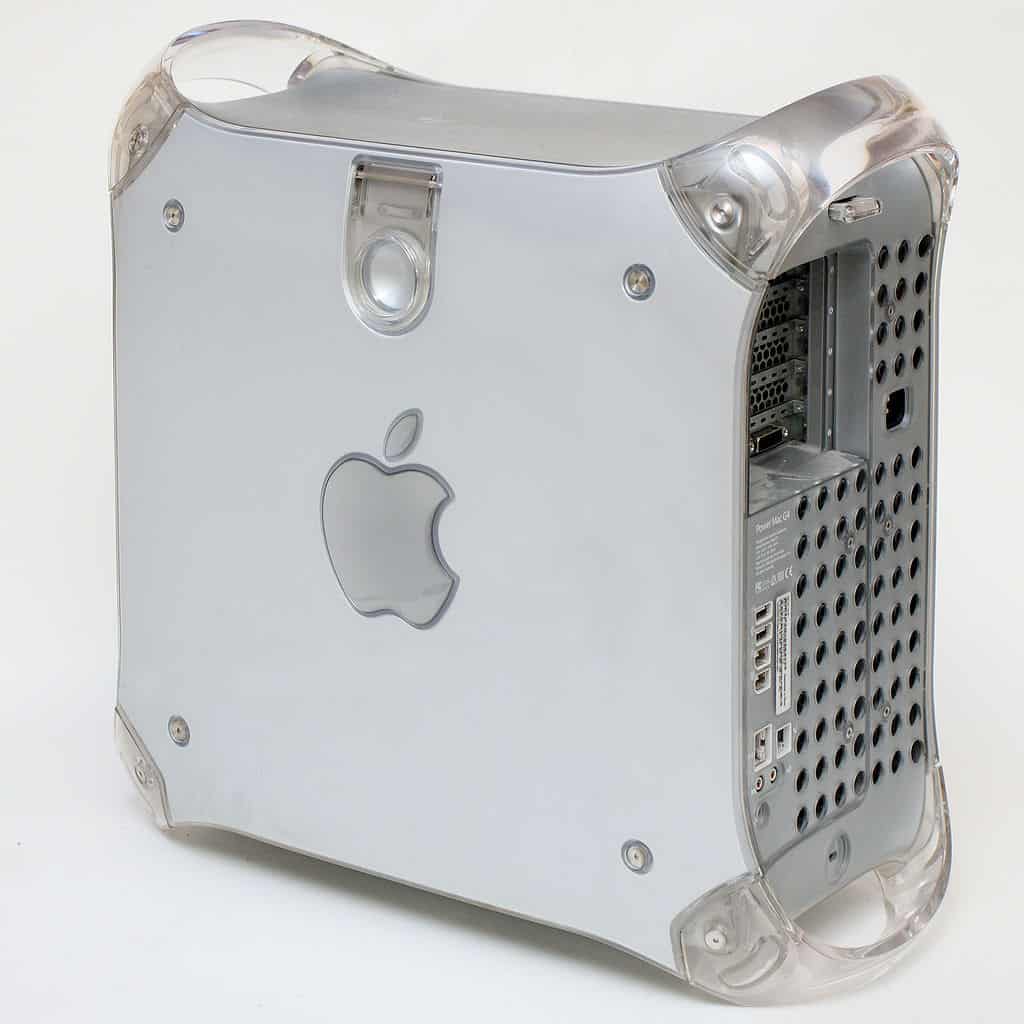From 1994 to 2006, the PowerMac was Apple’s flagship desktop computer tower. While the design has long since been discontinued in favor of Apple’s new Mac Pro desktop, the PowerMac was an essential precursor to modern desktop Macs. Let’s explore the unique history of the PowerMac, from the earliest models to the last holdouts in 2006. Ultimately, you’ll know whether these old Macs are still useful or they are just museum pieces.

Apple products have always been know for their sleek, modern design.
©Stefan Holm/Shutterstock.com
Apple PowerMac: Best Deal Today
With such a vintage machine as the PowerMac, you’ll have to do some digging to find anything worthwhile. Retail sellers have long since discontinued the PowerMac, and unless you happen to see one in the wild, the only place to find one these days is from third-party sellers on eBay. Most commonly available are the later G5 models.
- PowerMac G5 – eBay – $139
- PowerMac G5 – eBay – $179.95
- PowerMac G4 – eBay – $250
PowerMac: Overview
Apple has had a specialty for desktop home computers since its early years. The Apple I and Apple II release were groundbreaking desktop computers that shattered previous illusions of what was possible. As the 1980s progressed, Apple’s market share expanded, and product offerings widened to fit a broader audience.
With the Macintosh launch in 1984, the seeds were planted for what would become the PowerMac. All-in-one computers were all the rage at the start of the home computing revolution. Still, as the industry matured, many users realized the benefit of a system with a separate monitor and console.
The PowerMac would go on to become Apple’s proving ground for its latest hardware and most potent specs. While not very popular in the first few generations, the PowerMac would soon become the desktop computer of choice for creative professionals of all types.
Let’s discuss the most definitive versions of the PowerMac and discover how this computer has evolved over the decades.
Earliest Models
The PowerMac started off with early RISC-based processors made by IBM. These early experimental processors soon evolved into the PowerPC series, starting with the model 601. Unlike traditional CPUs of the time, the PowerPC processor was designed with specialized chips focused on providing better performance for graphics and drawing. As a result, designers, artists, and video editors fell in love with the PowerMac from the beginning.
The earliest commercial releases of the PowerMac were slated for January of 1994, ten years after the launch of the first Macintosh. Apple pushed back this date due to manufacturing delays, and on March 14, the first PowerMac was officially unveiled to the public.
The new system was a smashing success, with over one million units sold by 1995.
Move to Standardization
By the early 1990s, all Apple computers used proprietary hardware and connectors, making it difficult to interface or communicate with Windows PCs. This shrunk Apple’s market share, especially from the period after Steve Jobs left the company until his fateful return. In the meantime, Apple made efforts to standardize its computers.
Popular models released at this time include the Quadra and Performa series. With these models, Apple planned to transition from proprietary connections to standard PCI slots. This way, users could install own hardware from their favorite brand.
Additionally, as hard drive capacities got larger and disk speed increased Apple made efforts to replace SCSI interfaces found in earlier Macs. Newer systems included IDE interfaces instead, allowing PowerMacs to take full advantage of the latest storage capacities.
PowerMac G3

©Anton_Ivanov/Shutterstock.com
| Release Year | 1997 |
| Processor | 233MHz PowerPC G3 |
| Storage | 4GB IDE |
| RAM | 256MB |
| Graphics | ATI 2MB Vram |
| Original OS | macOS 8.0 |
| Original Price | $2400 |
The PowerMac G3 was initially launched in 1997, using the classic beige “industrial” design of earlier PowerMacs. However, upon Steve Jobs’ return, the PowerMac G3 got an overhaul to resemble the curves and colors of the newly released iMac G3.
While not as popular as the iMac, the PowerMac G3 with an intuitive form factor, would set the stage for the next generation of desktops. Users could access the internals by pulling a latch on the side of the case, revealing the motherboard and all internal components with an easy-to-access design.
PowerMac G4

©baku13, CC BY-SA 3.0 <http://creativecommons.org/licenses/by-sa/3.0/>, via Wikimedia Commons – Original / License
| Release Year | 1999 |
| Processor | 400MHz PowerPC G4 |
| Storage | 4GB IDE |
| RAM | 64MB to 1GB |
| Graphics | ATI 16MB Vram |
| Original OS | macOS 8.7 |
| Original Price | $1600 |
The PowerMac G4 got off to a weak start. After a weak yield of new processors, Apple reduced the clock speed on the new models, offering speeds of 350, 400, and 450MHz. While the design was similar to the later G3 models, the G4 was offered in various colors, ranging from graphite to silver.
The second generation PowerMac G4 brought with it immense improvements in processing power, with CPU speeds of 800MHz or higher. These PowerMacs were also offered in dual-CPU configurations, a feature typically found on servers.
Although the earliest G4s shipped with just 64MB of RAM, the later models were significantly upgraded. With the price of memory falling rapidly around this time, systems with significantly higher memory capacities each generation became common. The PowerMac G4 was a shining example of this. The later models could hold up to 1.5GB.
PowerMac G5
| Release Year | 2003 |
| Processor | 1.6 to 2.7GHz PowerPC G5 |
| Storage | 80GB SATA |
| RAM | 256MB to 4GB |
| Graphics | Nvidia 64MB Vram |
| Original OS | macOS 10.2 |
| Original Price | $2000 |
Touted as Apple’s first 64-bit computer, the PowerMac G5 received unanimous praise during its production. Although superior machines have since replaced it, the G5 was the paramount performance system at the time, loved for its raw computing power.
The PowerMac G5 was Apple’s most powerful desktop computer yet. Made from 2003 to 2006, it would mark the final chapter in the history of the PowerMac. Apple needed to switch from PowerPC to Intel processors out of necessity, as they couldn’t squeeze more performance out of the old platform. The PowerPC G5 chip would be the last CPU made before Intel Macs took over.
PowerMac: Review
Throughout its production, the PowerMac has received criticism and praise. While many users loved the design, many others hated it. The consensus was mixed. But one unanimous thing was the system’s benchmark performance.
Apple often claimed the PowerPC processor’s went toe-to-toe with Intel Pentium CPUs, but real-world benchmarks showed otherwise. Many third-party reviewers ran their own benchmarks, ultimately showing lower performance in office tasks. However, the performance in Photoshop and graphic design software was unparalleled. There was simply no better system for graphic design uses than a PowerMac.
Features
Some of the best features of the PowerMac were apparent because of the sheer size of the computer. With such a massive case, users were free to expand their hardware by several multiples. The early models could hold one or two hard drives. Newer G5 models has room for four.
Additionally, RAM was always massively upgradeable on PowerMac systems. With RAM prices falling rapidly throughout the early 2000s, having an upgradeable RAM was a plus. The high RAM capacities would make the PowerMac the computer of choice for an upgrade enthusiast. In fact, by the final PowerMacs, it wasn’t unheard of to see models supporting up to 16GB of RAM. This is competitive even by today’s standards, almost two decades later.
PowerMacs were also known to feature a wide range of ports, like USB, FireWire, and Parallel. They were also Apple’s first desktops to use USB ports alongside the iMac G3. As for graphics capabilities, the PowerMac was a first for Apple in that users could upgrade their own GPUs using industry-standard equipment.

The PowerMac was an essential precursor to modern desktop Macs.
©Jack Skeens/Shutterstock.com
PowerMac: What to Use Them For Today?
You may think the PowerMac is downright useless today, given its obsolescence. But you would be mistaken. While you can’t use the PowerMac like you would a regular system, there are still niche use cases that you may be interested in.
Unfortunately, even on the latest models from 2006, the processor architecture is vastly different from modern CPUs. This makes it extremely complicated to write new software or even run existing software for the PowerMac. For most uses, you’ll specifically need to source vintage software to load on your system.
If you have a knack for building computers and want to try to build a heavily modded PC, the PowerMac makes a great platform to start with. While the PowerMac G5 remains an obsolete piece of technology today, the heavy aluminum case on this model is still praised for its good looks and solid build quality.
For that reason, many modders enjoy ripping out the original components and building what is referred to as a “Hackintosh.” Since the original motherboard, CPU, and RAM are of no use for modern software, they are removed and replaced with a modern ATX motherboard and Intel or AMD processor.
All of this often requires the use of force to make everything fit. Since the PowerMac G5 doesn’t offer a sufficient mounting pattern or I/O panel for a different motherboard, everything must be built from scratch. As a result, building a Hackintosh out of an old PowerMac is a process only for highly experienced PC builders.
PowerMac: Pros and Cons
Pros:
- Unique hardware
- Classic Apple design
Cons:
- Obsolete
- No support
- Hard to find parts
Corsair PowerMac: Is It a Buy?
PowerMac might be old, but a tempting buy, especially if you love vintage computers. The unique design and classic Apple style make it a particularly attractive piece for anyone’s collection.
Buy it if…
You want an old Mac to restore or put on display. Restoring an old PowerMac can be a fun project if you plan on installing the original parts and loading the original operating system.
On the other hand, if you want to completely carve up the system and put your own modern components inside, you can do that too. The PowerMac’s spacious frame allows you to fit various motherboards, power supplies, and storage configurations. The only catch is that you’ll need to be crafty. Retrofitting an old Mac will require hands-on sawing, cutting, and calibrating in order to make everything fit. But if you can make it work, a PowerMac is the perfect base to build a Hackintosh.
Don’t buy it if…
You want a modern computer capable of going online and running popular applications. The PowerMac is simply too old. Even the newest PowerMac will make a very disappointing computer with obsolete hardware and software.
If you want something inexpensive to go on the internet, your money would be better spent on a Chromebook or a Windows 11 laptop. The PowerMac is best left to computer museums and vintage computer collectors.